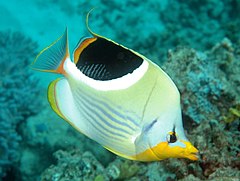Saddle butterflyfish
| Saddle Butterflyfish | |
|---|---|

| |
| Adult | |
| Scientific classification | |
| Kingdom: | |
| Phylum: | |
| Class: | |
| Order: | |
| Family: | |
| Genus: | Chaetodon (but see text)
|
| Subgenus: | Rabdophorus
|
| Species: | C. ephippium
|
| Binomial name | |
| Chaetodon ephippium G. Cuvier, 1831
| |

| |
| Saddle butterflyfish range.[2] | |
The Saddle Butterflyfish, Chaetodon ephippium, is a species of butterflyfish (family Chaetodontidae). It is found in the Indian and Pacific Oceans from Sri Lanka and the Cocos-Keeling Islands to the Hawaiian, Marquesan and Tuamoto islands, north to southern Japan, south to Rowley Shoals and New South Wales in Australia.[3]

It is a large butterflyfish, at up to 30 cm (nearly 12 in) long together with the Lined Butterflyfish (C. lineolatus) the giant among its genus. In shape it resembles certain angelfishes more than most of its relatives. The overall color is yellowish grey, with a large black spot bordered below by a broad white band on the back and wavy blue lines on the lower sides. The throat and the outline of the hind parts is bright yellow. Adults have a filament extending posteriorly from the upper part of the soft portion of the dorsal fin.[3]
The Saddle Butterflyfish is found at depths between 0 and 30 m in coral reefs. It feeds on filamentous algae, small invertebrates, coral polyps, and fish eggs.[3]
It belongs to the large subgenus Rabdophorus which might warrant recognition as a distinct genus. In this group, it appears to represent a distinct lineage, with the Dotted Butterflyfish (C. semeion) perhaps the only somewhat closely related species. Next closest seems to be a group including the Black-backed Butterflyfish (C. melannotus), Spot-tailed Butterflyfish (C. ocellicaudus) and Yellow-dotted Butterflyfish (C. selene), but these are already so distant that their ancestors must have diverged from the Saddle Butterflyfish's soon after the Rabdophorus lineage started to diversify.[4][5]
References
- ^ Myers, R. & Pratchett, M. 2010. Chaetodon ephippium. In: IUCN 2013. IUCN Red List of Threatened Species. Version 2013.1. www.iucnredlist.org. Downloaded on 10 September 2013.
- ^ International Union for Conservation of Nature (IUCN) 2010. Chaetodon ephippium. In: IUCN 2015. The IUCN Red List of Threatened Species. Version 2015.2. http://www.iucnredlist.org. Downloaded on 19 July 2015.
- ^ a b c FishBase [2008]: Chaetodon ephippium. Retrieved 2008-SEP-01.
- ^ Fessler, Jennifer L. & Westneat, Mark W. (2007): Molecular phylogenetics of the butterflyfishes (Chaetodontidae): Taxonomy and biogeography of a global coral reef fish family. Mol. Phylogenet. Evol. 45(1): 50–68. doi:10.1016/j.ympev.2007.05.018 (HTML abstract)
- ^ Hsu, Kui-Ching; Chen, Jeng-Ping & Shao, Kwang-Tsao (2007): Molecular phylogeny of Chaetodon (Teleostei: Chaetodontidae) in the Indo-West Pacific: evolution in geminate species pairs and species groups. Raffles Bulletin of Zoology Supplement 14: 77-86. PDF fulltext Archived 2007-08-11 at the Wayback Machine
External links
- Photos of Saddle butterflyfish on Sealife Collection

